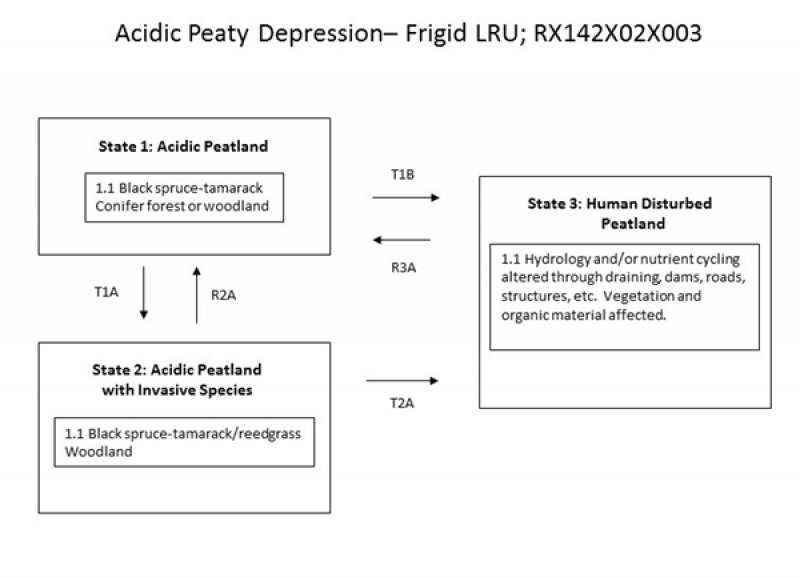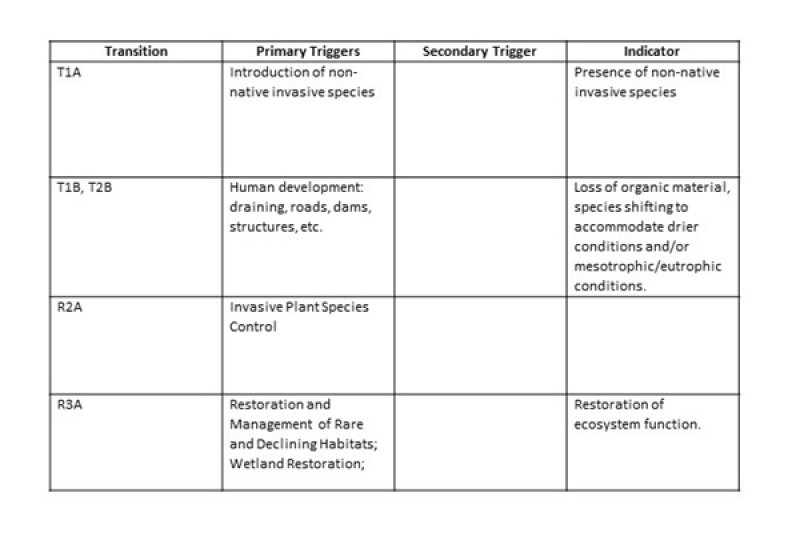
Natural Resources
Conservation Service
Ecological site F142XA003NY
Acidic Peaty Depression
Last updated: 10/03/2024
Accessed: 12/21/2025
General information
Provisional. A provisional ecological site description has undergone quality control and quality assurance review. It contains a working state and transition model and enough information to identify the ecological site.
MLRA notes
Major Land Resource Area (MLRA): 142X–St. Lawrence-Champlain Plain
This MLRA is a glaciated area of low relief dominated by broad expanses of nearly level, sandy deltas and shallow lacustrine basins or plains punctuated by low hills of glacial till. Rivers and streams have cut relatively deep but narrow valleys across the plain. Elevation ranges from 80 to 1,000 feet, increasing gradually from the St. Lawrence River southward and from Lake Champlain to the east and west. Local relief generally is less than 30 feet, but glacial till ridges, till plains, and some outwash terraces rise 15 to 80 feet above the adjacent plains.
This area has been glaciated, and a thin mantle of till covers most of the bedrock. Extensive areas of sandy glacial outwash and eolian deposits also occur. Some glacial lake sediments have been deposited above glacial moraines. These deposits are thickest in the valleys and thinnest on the ridges and highlands. During the later stages of the Wisconsin glacial period, seawater entered the Champlain Valley and deposited marine sediments that were later covered by freshwater sediments. The marine deposits are unique to the area.
This area supports hardwoods. The beech-birch-sugar maple forest type is the dominant climax forest type on uplands. Associated with this type are basswood, American elm, maple species, white ash, black cherry, and white pine. The aspen-birch type, earlier in succession, is economically important. Such species as eastern hemlock, red maple, American elm, and spruce are on wet soils.
Some of the major wildlife species in this area are white-tailed deer, red fox, raccoon, beaver, woodchuck, muskrat, cottontail, ruffed grouse, and woodcock.
Land Resource Unit (LRU): Frigid Soil Temperature Regime
The upper St. Lawrence and Champlain Valleys are characterized with soils in the frigid soil temperature regime (mean annual soil temperature greater than 32°F but less than 46°F and with a difference between mean summer and mean winter soil temperatures greater than 41°F at 20 inches below the surface or at a densic, lithic, or paralithic contact, whichever is shallower).
The Frigid Soil Temperature Regime (STR) will have shorter growing season than the lower St. Lawrence and Champlain Valleys which are characterized with soils in the mesic STR. Species more tolerant of colder year round temperatures would also be evident in the Frigid LRU.
Classification relationships
NRCS:
Land Resource Region: R - Northeastern Forage and Forest Region
MLRA: 142 - St. Lawrence-Champlain Plain
LRU: A/02 - Frigid Mean Annual Soil Temperature
USFS:
Domain: 200 - Humid Temperate
Division: 210 - Warm Continental
Province: 211 - Northeastern Mixed Forest
Section: 211E - St. Lawrence and Champlain Valley
Subsections: 211Ea - St. Lawrence Glacial Marine Plain
EPA:
Level I: 8 - Eastern Temperate Forests
Level II: 8.1 - Mixed Wood Plains
Level III: 83 - Eastern Great Lakes Lowlands
Level IV: 83d - St. Lawrence Lowlands
83e - Upper St. Lawrence Valley
Ecological site concept
Climate:
Mean annual precipitation is 38 inches and evenly distributed throughout the year. Most of the rainfall occurs as high intensity, convective thunderstorms during the summer. Snowfall is heavy from late in autumn to early spring. The average temperature in winter is 18°F and in summer it is 66°F. Average frost-free and freeze-free days are 124 and 147, respectively.
Geology:
The soils formed in organic material underlain by sandstone bedrock.
Landform/Landscape Position:
The site occurs in nearly level depressions on till plains. Slope ranges from 0 to 2 percent.
Edaphic:
The site consists of very poorly drained mucky organic soils. Depth to sandstone bedrock ranges from 16 to 50 inches. Soil pH ranges from extremely acid to ultra-acid throughout. Permeability above the bedrock is moderate or moderately rapid. Representative soil is Churubusco.
Vegetation Dynamics:
The reference plant community is a black spruce-tamarack bog woodland or forest which is common on acidic peatlands in cool environments (Edinger et al 2014). A black spruce-tamarack bog may grade into and form a mosaic with dwarf shrub bog, inland poor fen, and spruce-fir swamp (Edinger et al 2014) depending on local hydrology, minerology, and geomorphic conditions.
Characteristic trees include black spruce and tamarack. Canopy cover is quite variable, ranging from open canopy woodlands with as little as 20% cover of evenly spaced canopy trees to closed canopy forests with 80 to 90% cover (Edinger et al 2014). Characteristic shrubs include leatherleaf, sheep laurel, and highbush blueberry (Edinger et al 2014). Characteristic herbaceous plants are three-sided sedge, pitcher plant, and cinnamon fern. Various species of peat mosses are dominant as groundcover.
Research is needed to fill information gaps about black spruce-tamarack bogs, especially to advance the understanding of their classification, ecological processes (e.g., fire), hydrology, floristic variation, characteristic fauna, and bog development and succession (Damman 1987, Edinger 2014).
Associated sites
| F142XB001NY |
Mucky Depression |
|---|
Similar sites
| F142XA002NY |
Mucky Depression Frigid LRU Nutrient rich organic soils |
|---|---|
| F142XA014NY |
Wet Lacustrine Depression |
Table 1. Dominant plant species
| Tree |
Not specified |
|---|---|
| Shrub |
Not specified |
| Herbaceous |
Not specified |
Click on box and path labels to scroll to the respective text.

